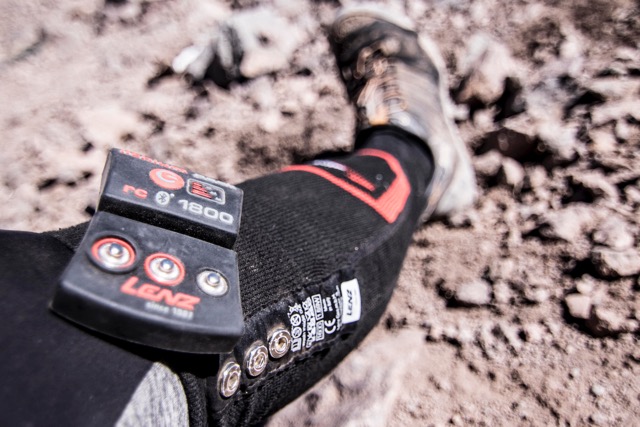‘Stamina level: 5%.’
That’s what my watch tells me, and I can’t say that I find the assessment faulty. I’ve been running and scrambling for close to 30 hours, interrupted only by a few hours of fitful rest atop 14,433ft Mount Elbert.
This summer is a big one for me. I have been hitting the trails to get ready for two objectives, the 400km Ultra Gobi and the mega-tough crown jewel of independent mountain running, Nolan’s 14. I’m typically not one for long weeks of strategically tracking and managing my training load (read this: ‘Sunny Stroeer’s FKT on the Annapurna Circuit is crazy’ - Outside Online), but with a single push 400 kilometer effort on the horizon I can’t afford the luxury of being lackadaisical. That’s why I’m pleased to have partnered with Coros to try out their new GPS adventure watch Vertix.
I’ve been using and testing the Vertix for a little over a month now - with more than 85 hours of tracked workouts up to 14,400ft - and I just only charged the watch for the second time since taking it out of the box. The battery life on the Vertix is mind boggling, but that’s only one of the many things that have impressed me.
Things I love about the Vertix:
Ease of use. The watch with its various modes and screen is highly intuitive. It doesn’t currently have a comprehensive user manual, and except for the finest of nuances it really doesn’t need one. With its three buttons and intuitive screen setup, there isn’t much of a learning curve.
The Coros app is equally intuitive and, after you’ve established the initial connection between your phone and the watch, stupendously smooth. Just open the app on your phone after you’ve finished a workout; your watch data syncs automatically and in a matter of seconds; no need to ever connect the watch to a computer. Coros also integrates seamlessly with Strava (and with that, finally succeeded in converting me into a diligent Strava user).
Built-in sensors measure heart rate and pulse oxygen (SpO2) levels directly on your wrist. As a high altitude endurance specialist I particularly love the SpO2 sensor, and use it frequently to monitor my acclimatization. I do know that wrist-based sensors aren’t medical grade (yet), and that’s OK with me - I’m looking for trends and patterns rather than a single absolute number.
Impressively accurate altitude measurements. Coros advertises altitude accuracy within 165ft, but I’ve found the watch to be much more accurate than that. As a matter of fact, most of my mountain workouts have been accurate within 30ft (for the summit elevation) with cumulative ascent and descent matching closely - a far cry from my old Suunto which would regularly show a discrepancies of 100s of feet for cumulative ascent and descent on an out-and-back.
Battery life. I already touched on this earlier, but need to reiterate it. 85 hours of tracked workouts (in standard 1-second GPS mode, and often in altitude mode which is harder on the batteries), yet I’ve just only had to charge the Vertix a second time since taking it out of the box. Beyond the amazing 60 hour standard-GPS mode battery life, there is also an UltraMax mode that stretches tracking capacity to 150 hours. You can bet that I’ll be using the feature in the Ultra Gobi where I expect to be racing for ~100 continuous hours.
Where I see room for improvement:
A generic workout mode would be nice. The watch offers indoor running and indoor cycling modes (neither of which I have tested, as they are not relevant to my training), but it would be nice to have a default general ‘workout’ mode that will track time, HR and calories for strength or cross-training sessions so that they will factor into the overall training load. ***Hot off the press: as of the last firmware update, this is now available!
Readability in difficult light environments. Even though the user can select their own favorite watch screen, and there is a display light function - which comes on automatically by the way if you are rotating your wrist towards your face at night - the watch would benefit from adding the option to inverse the display (from the current standard which is a black background with light lettering).
With extensive testing I have been able to surface a few minor bugs in the user interface on the app, which the Coros team is addressing in a very proactive manner with regular firmware updates. The issues that I’ve been able to discover have all been minor and are bound to impact only a tiny fraction of users until they are solved (example: the calculation of your cumulative training load may be incorrect if you start a workout on Day n and finish the workout on Day n+1.)
Mapping / navigation: I have to admit that I have not yet extensively tested the map function. The one time that I did try to use the watch to navigate back along my track, the navigation seemed less steady than I expected.
All in all… I am beyond excited to have made the switch to the Vertix, and I can’t wait to put it through the paces during the Ultra Gobi and other future endurance projects. Coros may be the new kid on the block in the GPS watch market, but they’re wise beyond their years. Garmin and Suunto better watch out!
Disclosure: I received a free Vertix unit so I could test it, but I am not being compensated for writing this review. I do not have any financial incentive for endorsing Coros nor do I receive commission on Vertix purchases resulting from this review.
That said, if you are in the market for a new GPS watch and DO want to buy a Vertix you can use code ‘sstroeer’ on the Coros website to receive an extra watchband with your purchase to customize your watch.








































